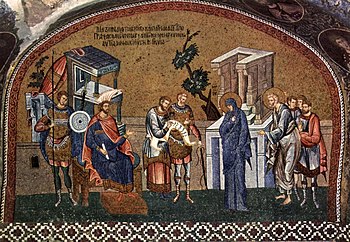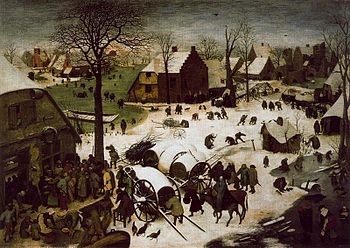Did the Romans Make People Travel for the Census

The Demography of Quirinius was a census of Judea taken by Publius Sulpicius Quirinius, governor of Roman Syria, upon the imposition of straight Roman rule in 6 CE.[ane] The Gospel of Luke uses information technology to engagement the nativity of Jesus, which the Gospel of Matthew places in the time of Herod the Keen, who died in 4 BCE. Luke appears to have conflated Quirinius'southward demography with the death of Herod,[two] and most critical scholars acknowledge a defoliation and misdating by Luke.[3]
Overview [edit]
Herod I (Herod the Great), c. 72 – 4 BCE, was a Roman client king whose territory included Judea. Upon his expiry, his kingdom was divided into three, each section ruled by one of his sons. In half-dozen CE, Emperor Augustus deposed Herod Archelaus, who had ruled the largest section, and converted his territory into the Roman province of Judea. Publius Sulpicius Quirinius, the legate (governor) of the province of Roman Syria starting in 6 CE,[four] was assigned to carry out a census of the new province of Judea for taxation purposes.[1] This was a property tax, and required that the value of real property be registered along with the identity of the owners.[5] The census triggered a revolt of Jewish extremists (called Zealots) nether the leadership of Judas of Galilee.[6] (Galilee itself was a separate territory under the rule of Herod Antipas.) Judas seems to have plant the census objectionable because it ran counter to a biblical injunction (the traditional Jewish reading of Exodus 30:12) and because it would pb to taxes paid in heathen coins begetting an image of the emperor.[7]
In the gospels [edit]

While the Gospel of Mark (composed c. 68 CE) lacks a nascence story, the Gospel of Matthew (c. 88 CE) places Jesus'due south birth in the time of Herod I.[viii] Contrarily, the Gospel of Luke (as well c. 88 CE) correlates Christ's birth with the demography:
In those days a decree went out from Emperor Augustus that all the world should be registered. This was the first registration and was taken while Quirinius was governor of Syria. All went to their own towns to be registered. Joseph as well went from the town of Nazareth in Galilee to Judea, to the city of David called Bethlehem, because he was descended from the house and family of David. He went to be registered with Mary, to whom he was engaged and who was expecting a kid.
Luke's credible conflation of the 6 CE census with the 4 BCE expiry of Herod I have led most biblical scholars to acknowledge that the gospel is wrong.[9] [ten] Luke seems to have incorporated the census to movement Joseph and Mary from Nazareth, "their own city" (Luke 2:39), to Bethlehem, where the nativity was to occur. (The writer of Matthew had the reverse problem; believing that Joseph, Mary and Jesus lived in a firm in Bethlehem prior to their flying into Egypt, they motion to Nazareth to avert the recently appointed Herod Archelaus.)[3] [11] Luke's author may likewise have wanted to contrast the rebellious Zealots with the peaceable Joseph and Mary, who had obeyed the Roman edict, and to find a prophetic fulfilment of Psalm 87:6: "In the census of the peoples, this one will be born there." (In the Greek or Septuagint version, it is "princes" who will exist born.)[12] The Gospel of John (c. 100 CE) portrays Christ's nascency in Bethlehem every bit fulfilling a prophecy of Micah.[13]
Scholars point out that there was no unmarried census of the unabridged Roman Empire under Augustus and the Romans did not directly taxation customer kingdoms; farther, no Roman census required that people travel from their own homes to those of their ancestors. A census of Judea would not have affected Joseph and his family, who lived in Galilee nether a different ruler; the revolt of Judas of Galilee suggests that Rome'due south direct taxation of Judea was new at the time.[four] [14] [3] Catholic priest and biblical scholar Raymond E. Brown postulates that Judas's place of origin may take led the author of Luke to recollect that Galilee was bailiwick to the census, although the region is clearly distinguished from Judea elsewhere in the gospel.[15] [16] Brownish also points out that in the Acts of the Apostles, Luke the Evangelist (the traditional author of both books) dates Judas'south census-incited revolt as following Theudas'south rebellion of four decades subsequently.[15]
Some religious scholars take made attempts to reconcile Luke's dating disparity.[17] Some suggest that Quirinius might have served two terms as governor Syria and conducted two censuses in Judea, just the career of Quirinius and the names and dates of the governors are well documented and there is no fourth dimension before six CE when he could have served as governor of Syria.[iv] Anglican bishop Paul Barnett theorizes that an earlier demography unrelated to taxation took place, which Chocolate-brown points out requires the scripture to be reinterpreted to mean that the census took place before Quirinius'south tenure.[17] Géza Vermes describes attempts to defend the historicity of the biblical birth narratives as "exegetical acrobatics";[18] Ralph Martin Novak points out that such views spring from the belief that the Bible is without error.[xix]
Encounter also [edit]
- Chronology of Jesus
- Date of nativity of Jesus
- Gospel harmony
- List of Roman governors of Syria
- Roman administration of Judaea (AD six–135)
- Roman conscience
References [edit]
- ^ a b Gruen 1996, pp. 156–157.
- ^ Edwards 2015, p. 71.
- ^ a b c Dark-brown 1978, p. 17.
- ^ a b c Novak 2001, pp. 293–298.
- ^ Novak 2001, p. 290.
- ^ Stern 1976, p. 274.
- ^ Skarsaune 2008, p. 127.
- ^ Matthew two:16–18
- ^ Novak 2001, p. 292.
- ^ Brown 1977, p. 17.
- ^ Matthew 2:23
- ^ Brownish 1978, p. nineteen.
- ^ Muss-Arnolt 1897.
- ^ Dark-brown 1977, pp. 552–553.
- ^ a b Brownish 1977, p. 413.
- ^ Luke 3:1
- ^ a b Brown 1977, p. 552.
- ^ Vermes 2010.
- ^ Novak 2001, pp. 296–297.
Bibliography [edit]
- Brown, Raymond East. (1977). The Nativity of the Messiah: A Commentary on the Infancy Narratives in Matthew and Luke. Doubleday & Company.
- Brown, Raymond E. (1978). An Adult Christ at Christmas: Essays on the Three Biblical Christmas Stories. Liturgical Press. ISBN9780814609972.
- Edwards, James R. (2015). The Gospel of Luke. Eerdmans. ISBN9780802837356.
- Gruen, Erich S. (1996). "The Expansion of the Empire Under Augustus". In Bowman, Alan K.; Champlin, Edward; Lintott, Andrew (eds.). The Cambridge Ancient History. Vol. ten. Cambridge University Press. ISBN9780521264303.
- Muss-Arnolt, W. (1897). "Helps to the Study of the Earlier Prophets". The Biblical Globe. 9 (6): 443–456. ISSN 0190-3578.
- Novak, Ralph Martin (2001). Christianity and the Roman Empire: Background Texts. Continuum International. ISBN9780567018403.
- Skarsaune, Oskar (2008). In the Shadow of the Temple: Jewish Influences on Early Christianity. InterVarsity Printing.
- Stern, Grand. (1976). "The Flow of the 2d Temple". In Malamat, Abraham; Tadmor, Hayim (eds.). A History of the Jewish People. Harvard Academy Press.
- Vermes, Géza (2010). Jesus: Nativity - Passion - Resurrection. Penguin. ISBN9780141957449.
External links [edit]
-
 Media related to Census of Quirinius at Wikimedia Commons
Media related to Census of Quirinius at Wikimedia Commons
0 Response to "Did the Romans Make People Travel for the Census"
Post a Comment